
Many homeowners dream of installing a swimming pool but are understandably concerned about safety. Whether you have your own kids or grandkids, other family members with special needs, or you’re concerned about neighborhood children and pets, you’re very right to consider the potential risks. Nearly 900 children drown each year in the US, and many others suffer frightening accidents.
And of course, that is precisely the reason so many municipalities impose rules on pool safety. You want to keep everyone safe while also complying with local laws. So, what are your options for swimming pool safety?
Whether you already own a pool and want to make it safer, or you’re considering a brand-new installation, the following safety features might appeal to you.
Fencing. Fencing provides a physical barrier to keep wandering children or pets away from the pool and is usually required for all pool owners depending upon local laws. Portable fencing, consisting of mesh fabric attached to stakes, can provide a barrier against entry. But as we all know, children and pets can be quite determined. A permanent fence is even better. Chain link fencing can be too easy to climb, so a tall (height based on your city/county zone) privacy fence offers the most protection.
Of course, no fence will prevent entry to your pool unless the gate is kept closed and locked. And if objects are pushed up against the side of the fence, they can provide easy access to skillful climbers.
Check your local laws before choosing a fence for your pool area, as type and height are often specified requirements.
Alarms. Your pool can be equipped with an alarm that alerts you any time the surface of the water is broken, allowing you to get outside and respond quickly. However, many homeowners would rather not rely solely upon their own lifeguarding abilities. A second (or even third) alarm system can alert you when your backyard fence perimeter is breached, the gate is opened, or even when the back door to your own home is opened (by a curious child wandering outside). Multiple layers of alarms, depending upon your needs, provide the best protection.
Many homeowners dream of installing a swimming pool but are understandably concerned about safety. Whether you have your own kids or grandkids, other family members with special needs, or you’re concerned about neighborhood children and pets, you’re very right to consider the potential risks. Nearly 900 children drown each year in the US, and many others suffer frightening accidents.
And of course, that is precisely the reason so many municipalities impose rules on pool safety. You want to keep everyone safe while also complying with local laws. So, what are your options for swimming pool safety?
Whether you already own a pool and want to make it safer, or you’re considering a brand-new installation, the following safety features might appeal to you.
Fencing. Fencing provides a physical barrier to keep wandering children or pets away from the pool and is usually required for all pool owners depending upon local laws. Portable fencing, consisting of mesh fabric attached to stakes, can provide a barrier against entry. But as we all know, children and pets can be quite determined. A permanent fence is even better. Chain link fencing can be too easy to climb, so a tall (height based on your city/county zone) privacy fence offers the most protection.
Of course, no fence will prevent entry to your pool unless the gate is kept closed and locked. And if objects are pushed up against the side of the fence, they can provide easy access to skillful climbers.
Check your local laws before choosing a fence for your pool area, as type and height are often specified requirements.
Alarms. Your pool can be equipped with an alarm that alerts you any time the surface of the water is broken, allowing you to get outside and respond quickly. However, many homeowners would rather not rely solely upon their own lifeguarding abilities. A second (or even third) alarm system can alert you when your backyard fence perimeter is breached, the gate is opened, or even when the back door to your own home is opened (by a curious child wandering outside). Multiple layers of alarms, depending upon your needs, provide the best protection.
Pool covers. A pool cover seems like an obvious safety solution but be careful to choose an appropriate one. Some are designed only to keep debris out of the pool, and not with safety in mind. Look for a pool cover that is ASTM F1346-91 certified, meaning it won’t collapse when people walk on it, nor allow a child to crawl underneath.
A pool net can be easier to maneuver and allow you to actually see if anyone has slipped under it. But children and pets can become tangled in them, making nets a riskier option if not used in conjunction with fencing and alarms.
Safety guidelines. Accidents can happen even with adults present. In addition to a smart security system, make sure you’ve purchased the appropriate rescue equipment. Ask parents to take turns as designated “water watchers” at pool parties, and never assume that someone else is watching the kids if you must step away. Communication and vigilance are key to keeping everyone safe around water, particularly small children.
If you’re considering a swimming pool installation, or already own a pool, contact us about the safety options available. We can help you design a beautiful backyard pool, while also keeping it safe for the whole family to enjoy for years to come.
A pool cover seems like an obvious safety solution but be careful to choose an appropriate one. Some are designed only to keep debris out of the pool, and not with safety in mind. Look for a pool cover that is ASTM F1346-91 certified, meaning it won’t collapse when people walk on it, nor allow a child to crawl underneath.
A pool net can be easier to maneuver and allow you to actually see if anyone has slipped under it. But children and pets can become tangled in them, making nets a riskier option if not used in conjunction with fencing and alarms.
Safety guidelines. Accidents can happen even with adults present. In addition to a smart security system, make sure you’ve purchased the appropriate rescue equipment. Ask parents to take turns as designated “water watchers” at pool parties, and never assume that someone else is watching the kids if you must step away. Communication and vigilance are key to keeping everyone safe around water, particularly small children.
If you’re considering a swimming pool installation, or already own a pool, contact us about the safety options available. We can help you design a beautiful backyard pool, while also keeping it safe for the whole family to enjoy for years to come.

Throughout our recent drought, you might have read or heard the acronym “WUCOLS” quite a lot. What does this stand for, and why do we care?
WUCOLS stands for Water Use Classification of Landscape Species, and it refers to the amount of water required to maintain any particular species of plant used in landscaping. The University of California Davis actually maintains a WUCOLS website that includes a plant search database and downloadable plant lists to aid landscapers in choosing plants appropriate for any landscape’s water needs. Over 3,500 plant groups are identified and analyzed, so that landscapers can make wise choices with regard to water use.
As the website states, “Water conservation is an essential consideration in the design and management of California landscapes. Effective strategies that increase water use efficiency must be identified and implemented. One key strategy when landscaping is to group plants with similar water requirements. By supplying only the amount of water needed to maintain landscape health and appearance, unnecessary applications that exceed plant needs can be avoided. Doing so, however, requires some knowledge of plant water needs.”
The database assigns a classification to each plant on the list, based on its water needs: Very low, low, medium, and high. Classifications are specific to California, and even to individual regions of the state, based on how much water each plant can be expected to require in a particular environment.
Examining the WUCOLS list will help you to choose plants based on your own preferences for lowering your water bill or the time spent maintaining your landscape. You will also be able to group plants with similar needs, so that each is more likely to thrive. But the list can also help all of us to lower the environmental impact of our choices, and prevent future droughts from getting out of control.
For more help with designing your landscape to promote responsible water use, give us a call. We will discuss your goals and then create a plan to limit your need for irrigation, ensure healthier, thriving plants, and support your community in years to come.
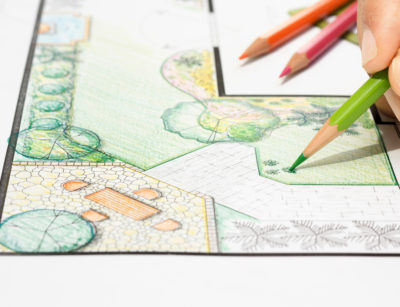
A garden is typically a place of beauty, that accentuates your home and perhaps contributes to its market value. But a garden can also serve as a spot for relaxing, feeling a connection with nature, and even honoring the memory of a loved one. When you plant a memorial garden, you can devote your care and energy to someone you’ve lost, while creating something meaningful for yourself and others to enjoy.
A memorial garden can be as simple or as elaborate as time and your chosen space allow. As with any garden, consider the size of your space first. Will it allow for a large root system and the height of a mature tree in the future? Or do you need to plan for something more compact?
Light is always another important consideration for any garden. Choose plant species that will thrive in a sunny or shady location, as applicable to your situation. Consider nearby buildings and shade from mature nearby trees.
And of course, any garden requires labor from you (or someone you hire) to maintain it. A lovely tree that you nurture for many years, marked with a thoughtful plaque, can honor your lost loved one just as well as an abundance of exotic flowers. You might also consider elements that your loved one enjoyed, such as a favorite color or type of rose.
If you plan to use your memorial garden as a place to relax and commune with nature, consider your seating options. A rocking chair on the porch, overlooking a memorial flower garden, might recall your memory of a special grandparent. Or you could have a bench specially designed and installed, including a plaque with the name of your loved one. Sometimes a swing or even a hammock might feel more appropriate, considering the personality of the one you wish to honor.
It is sometimes said that grief is simply love that has nowhere to go. Over time, your care of a memorial garden will give you an outlet for loving energy, and allow you to release these feelings in a healing way.
Call us to discuss your hopes for a memorial, and we can help you design something that honors your memories.
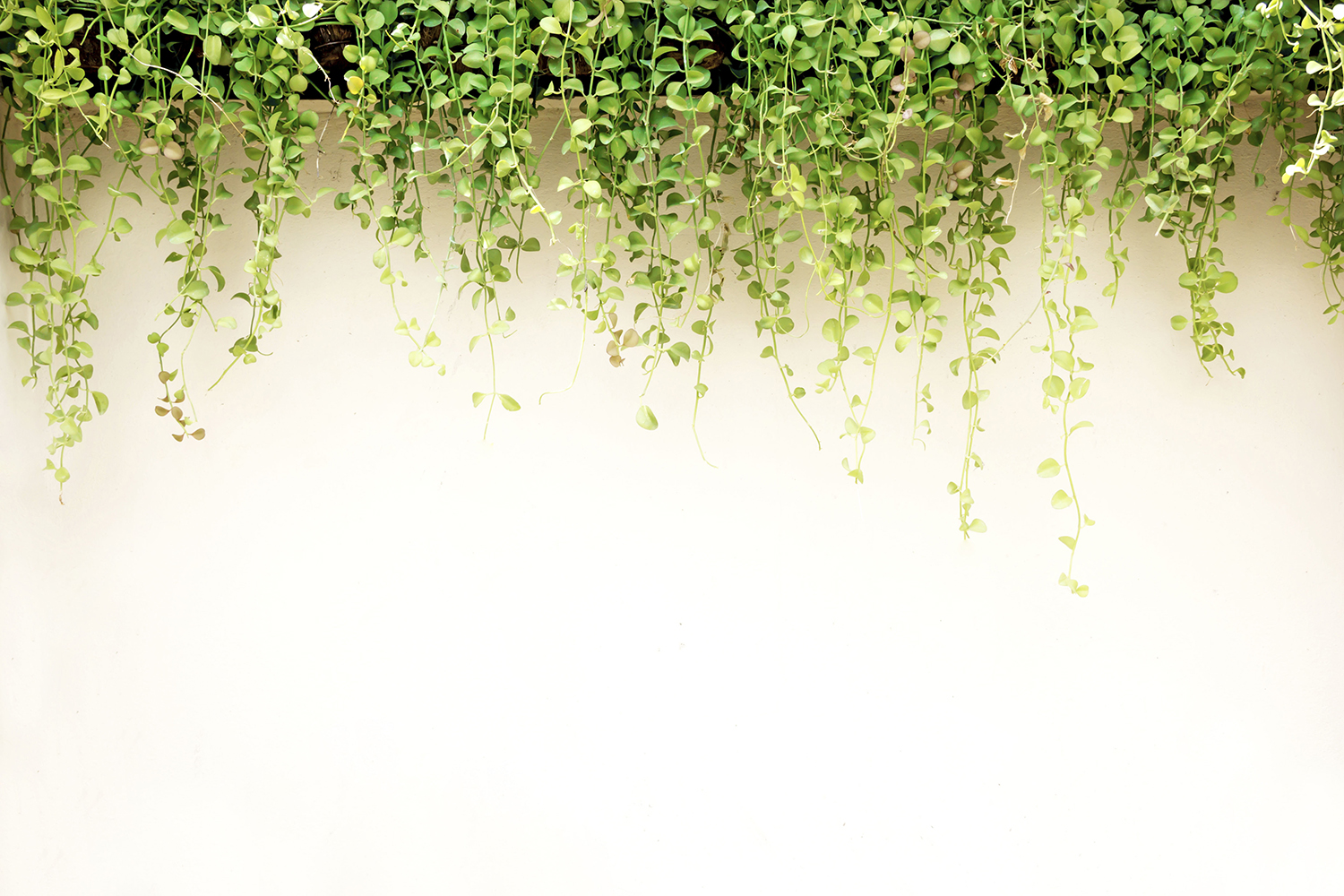
You move into a new home, and quickly discover a pest in your yard. Or your neighbor brings home a pest, and to your annoyance, it spreads into your landscaping! No, we’re not talking about groundhogs or moles… Many species of plants can be surprisingly invasive and persistent! So what can you do about a plant that threatens to take over your entire garden?
We often see stories like these, regarding bamboo, ivy, mint, and equisetum (horsetails). But other invasive plants exist, too. A plant is considered “invasive” when it has been transported outside of its natural environment, and then causes harm in its new location. This often happens because a species outside of its natural location will not face its usual challenges such as herbivores, insects, or diseases.
The danger of invasive plants lies in their ability to spread so quickly that they steal resources from other species. For example, ivy and kudzu are known to climb trees and eventually smother them, because the lush leaves absorb most of the light and air that would normally reach the tree.
And of course, invasive plants take a disproportionate amount of nutrients from the soil that would normally be shared by many co-existing species. That’s probably why you don’t want bamboo or equisetum spreading into your yard.
So, how do you get rid of invasive species in your yard? Three primary methods exist, and sometimes you might need to take a multi-pronged approach. Mechanical removal means that you simply cut the plant out of the landscape, including the roots. Chemical removal will require the use of herbicides, which can be dangerous to the surrounding environment and even your own health. And biological removal means that you introduce species that compete with the invasive one, to hopefully combat its spread. But of course, you might then have a new invasive species to worry about!
All of the above methods offer both benefits and drawbacks. And depending upon the species of plant that you’re battling, certain methods might work better at specific times of year. So our main recommendation is that you call us to discuss your particular problem in more detail, so that we can offer you additional advice on how to rid yourself of it. Then we can help you heal the damage to your yard, and plant more appropriate species for both beauty and biodiversity on your property.
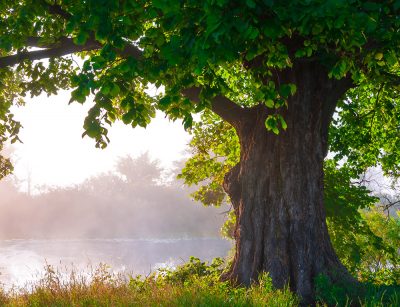
Oak trees contribute numerous benefits to a home’s landscape. Not only are they beautiful; their towering height also means an oak tree can provide much-needed shade (which can lower energy bills) to your home. And if you enjoy seasonal color, many varieties of oak tree are deciduous, meaning their leaves change color in autumn.
The most common types of oak tree in Southern California include:
● Coast live oak
● Interior live oak
● Engelmann oak
● Island oak
● Blue oak
● Black oak
● Valley oak
You might have noticed that a couple of these trees include the word “live” in their names. A live oak is one that “lives” through the winter; in other words, its leaves stay green all year, rather than turning brown and falling off in autumn. This makes live oaks a great choice for those of you who want the splendor of a large oak tree in your yard, but without the yearly mess and hassle of raking and bagging leaves.
Oaks have existed in California before the land was settled, but widespread deforestation due to the lumber and real estate industries has greatly reduced their numbers. But because trees are so important to our environment, many states, including California, have begun to offer the trees legal protections.
According to California state law, you cannot remove an oak tree from your property unless you apply for and receive the appropriate permit. But permits are issued by cities, each imposing different rules, so it is vital to communicate with your municipality’s permit office before attempting to remove an oak tree. If you do so unlawfully, you could face court action and a fine.
Whether you want to plant an oak tree or remove one, call us for expert landscaping advice. We can help you decide what types of tree meet your aesthetic and care preferences, and design a landscape that suits your particular space.
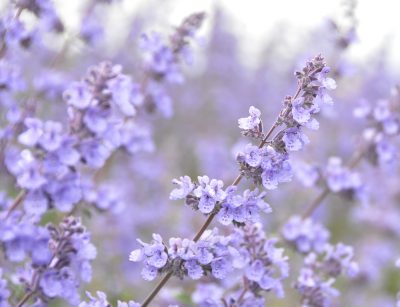
When you think of French and Mediterranean design, a farm in California might not be the first thing that leaps to mind. But a married couple – she an interior designer, he an architect – have created an oasis of strong southern European influence at the Patina Farm in Ojai, California. After touring the farm or simply viewing pictures, you might wish to bring the Patina vibe to your own home and gardens.
No Provencal-style Garden is complete without herbs such as lavender and rosemary. Not only do these make lovely accents to the garden; the herbs emit a lovely fragrance so that your landscaping can be an olfactory adventure rather than just a visual one. And of course, you can use your home-grown herbs in your cooking.
Meandering walkways invite the casual observer to enjoy landscaping on foot, rather than from a window. And when lined with well-groomed shrubbery, the garden feels truly magical.
A neutral palette of whites and beiges should be lightly accented with soft pastels of rose, peach, minty green or sky blue. Gardens of mostly white flowers are offset by carefully selected urns, planters, and garden finials. A water feature adds to the exotic ambiance.
And what would a European estate be, without fruit trees? While you might not have room for an entire orchard on your property, planting one or two fruit trees can help to create a min-farm atmosphere with a Mediterranean feel. Choose apple, citrus, fig, or pear varieties. Just remember that if you want the trees to produce fruit, some species require the presence of two or more trees.
Finally, remember that gardens serve more than a visual purpose. With appropriate seating, you can dine luxuriously al fresco, enjoying leisurely meals in a backyard space that reminds you of a fine European resort.
For more information on this design trend, call us to speak with one of our landscape designers. We can help you redesign the gardens of your dreams, in any sized space.
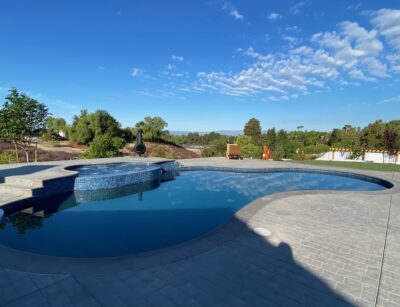
As you plan your swimming pool installation or renovation, you’re likely hoping for a pool that is just as beautiful as it is functional. We have some good news: With a wide variety of pebble interior options available, we can help you identify a look that suits your backyard as well as your practical needs.
While you can certainly opt for the traditional plaster finish, it will need to be replaced after 8 to 12 years. That’s why many homeowners are considering pebble or quartz aggregates to extend the life of their pool’s interior.
Aggregate pebble finishes provide the most “natural” look and feel. If you want to feel as though you’re swimming in your own private tropical lagoon, an aggregate pebble finish is for you! In the past, some pool owners felt that the larger pebbles were a bit hard on hands and feet, but the newer versions are considerably more comfortable. That means you can go for the look you want, without sacrificing comfort.
Mini pebble aggregates also provide a textured look, in a variety of colors, but are known to be a bit smoother and more modern in appearance. Keep in mind that the color of your pool finish will influence the appearance of the water. That’s why so many pebble aggregates are constructed in shades of blue and green. But for an added pop of texture and visual interest, bits of black, brown, and/or white can be added as well.
Both types of pebble interiors are known to last 12 to 14 years, on average.
Quartz options offer a luxurious upgrade from standard pebble aggregate. Not only is quartz extremely strong and durable; it can be personalized in a variety of colors to suit any design scheme. Because quartz aggregate creates a textured look, the occasional scratch in your pool’s surface will be well disguised. But because quartz is such a hard mineral, scratches tend to be cosmetic in nature only. Quartz is one of the most durable pool surfacing materials, so the initial investment tends to pay off in the long run. A quartz pool interior could outlast plaster by 10 years or more!
While price is often a consideration, we want to help you choose the pool surface that suits your needs for both aesthetic appeal and durability. Call us to schedule your own consultation, and we’ll get your pool built or refinished according to your own standards and budget.
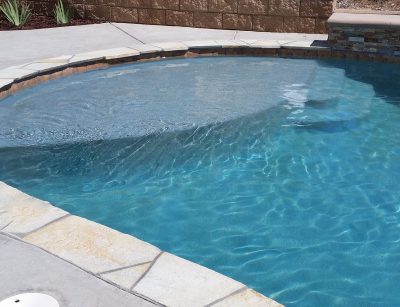
At some point during the planning process for your swimming pool, you will discuss the concept of pool coping with your contractor. In masonry terms, coping refers to the material used to cap the top of a wall. In swimming pool construction, the term refers to the material placed around the top of the pool where it meets the surrounding patio or deck. You will probably want some type of coping around your pool, for a few good reasons.
Pool coping performs a number of practical functions. It creates a barrier that prevents water from leaking behind the pool wall, which is a common cause of damage to swimming pools. It also helps to ensure that no critical elements of your pool are exposed to the elements in the event of shifts in the surrounding deck (such as from soil contraction or expansion).
Coping also contributes to pool maintenance in a small way. Because it overhangs the surface just slightly, coping can prevent some runoff water from causing damage to the pool, such as staining and calcium deposits.
And when installed on a slight angle, pool coping can direct splashed pool water into drains in the deck. This can prevent pooling water on the deck, which can damage it over time.
For some swimmers, coping can even perform an added safety function. While you should include other safety features in your pool design, it can be helpful to know that weaker swimmers can easily grab onto the coping in the event they feel overexerted. Coping also helps swimmers easily exit the pool if they aren’t near a ladder.
And of course, coping simply makes the pool look nice! It can be constructed from a variety of materials, like concrete, tile, or stone, to create an eye-pleasing edge around your pool. Pool designers actually refer to coping as the “edge treatment”, and can create coping to complement a variety of design schemes.
As you plan your swimming pool project, let’s discuss your options for pool coping. With a wide variety of materials and price points from which to choose, we can create pool coping that is both pleasing to the eye and functional to meet your needs.

We’ve all experienced our fair share of Easter egg hunts over the years, and after some time the same old celebrations can feel stale. As the kids get older, you probably want to liven up your celebrations to keep them relevant to your family and guests. Or if you don’t have kids, you hope to host a more adult celebration. These five ideas can get you started.
Host a “Crafternoon.” Instead of the usual morning egg hunt, invite friends over for an afternoon of crafting. Purchase a variety of crafting supplies, plan a few themed projects, and let everyone go wild with creativity.
Host an Easter brunch. For a more sophisticated celebration, invite your loved ones over for a spring-themed brunch. An omelet bar, deviled eggs, quiche, chicken-based dishes, or spring veggies round out a delicious, late-morning menu. Don’t forget beautiful, fresh-cut flowers for the table.
Get the adults involved. Egg hunts can be fun for adults, too! Hide eggs in more challenging spots, and fill them with clues to a puzzle that everyone must solve together. Or, give away fun prizes that adults will appreciate.
Host the Spring Games of 2023. Hold an Olympics-style competition, but with silly Easter-themed games instead of serious sports. Challenge party guests to the Bunny Hop, Bobbing for (Hardboiled) Eggs, or Spoon Race.
Take your hunt on the go. Rather than hosting your gathering at home, take it to a nearby park, conduct a scavenger hunt around town, or head out on a nearby hiking trail. But if you hide eggs in public spaces, make a list or take photos on your smartphone so that you can remember to collect them all.
As always, give us a call if you feel that your outdoor space doesn’t match your entertaining needs. We can help you plan for new landscaping, hardscaping, garden space, or fun features like a waterfall or fire pit. Let’s discuss your ideas and make a plan for a backyard you can enjoy in all seasons!
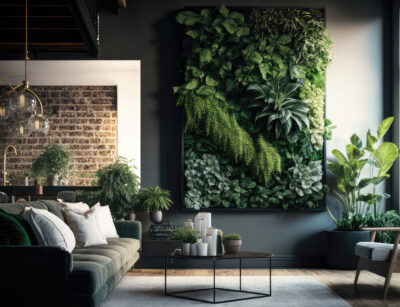
“Sustainability” is a word you’ve probably heard a lot in recent years. It’s true that we need to change the way we live in order to minimize our impact on their environment as the population surges. But that’s a lot easier to do when we design structures and landscapes with sustainability in mind from the outset, rather than trying to work within outdated concepts later. That’s the point of biophilic design, which focuses on wellbeing and sustainability, by combining a reverence of nature with architectural and landscape design.
Biologist and writer Edward O. Wiley introduced the idea of biophilic design in his 1984 book, Biophilia. So it’s not even a new concept! But the biophilic design trend is gaining incredible speed lately, as public attention shifts toward ideas that help us to reconnect with nature.
Most of us have become aware that we’re unhappy living in concrete jungles devoid of much plant life or other connection with the natural world. In addition, more “green” designs help us to minimize our impact upon the very environment we enjoy. Biophilic design incorporates several core features, including:
- Natural light, which is good for our circadian rhythms
- Ventilation for to bring fresh air indoors
- A focus on natural forms and shapes
- Views of nature, both real (via large windows) or imagery (murals, paintings, etc)
- Natural colors and earth tones
- Green walls and rooftops
- Elements from nature, such as plants and water
Are your mental gears turning yet? Yes, you can incorporate the elements of biophilic design into any space, whether you’re renovating your current home or planning to build a new one. If you want to include your landscape in this process, call us to learn more about our design process. We can help you feel more connected with nature, while creating responsible and sustainable designs for you home.
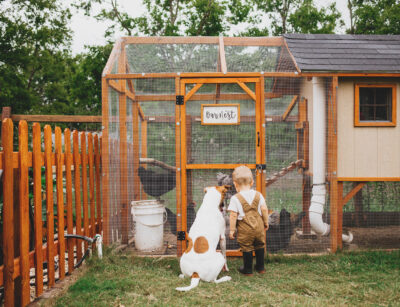
Backyard chicken coops are all the rage in the past few years. Keeping your own flock can help you provide healthy, fresh food to your family with minimal effort. And now, with the price of eggs skyrocketing, you might be more interested in chickens than ever!
But first, you will need a chicken coop. No, you don’t have to resign yourself to an unattractive, smelly mess that only serves as an eyesore in your backyard. Get creative with your chicken coop, and you’ll find that it becomes an attractive and even whimsical focal point in your garden.
These ideas can get you started, but feel free to let your imagination wander. Chickens aren’t too fussy and can be kept almost anywhere, with a few key considerations, of course.
Consider a children’s playhouse. You can probably find a used children’s playhouse for free or cheap on Facebook Marketplace or another site. Use wire mesh panels to block the windows, and you have a cute chicken house with minimal building effort.
Repurpose a potting shed or large doghouse. These buildings can also be repurposed as chicken houses, and you should view them as a blank slate. Paint them any color you want, and landscape around the structures so that they look natural in your garden.
Showcase your sense of humor. Many chicken keepers on Instagram and Pinterest are happy to show off their amusing designs. From Old West-style “towns” to a miniature replica of a Kentucky Fried Chicken restaurant, the ideas to display your sense of humor are endless.
Add a sign. For some reason, funny chicken house signs are a whole niche of product these days. And we’re on board with the trend! Adding a sign or two provides an amusing touch that your visitors will enjoy.
Remember a nesting box. Depending upon how many hens you keep, you will need one or several nesting boxes. Place these where you can easily retrieve the eggs and clean them periodically.
Just remember safety. A number of predators love to feast on chickens, and many of them are nocturnal. Make sure your chicken house is secure from racoons, dogs, and other hungry pests. Even if you allow your chickens to roam during the day, they should be secured at night.
And if you want to build a coop from scratch, give us a call. We can help you fit it into your landscape design.
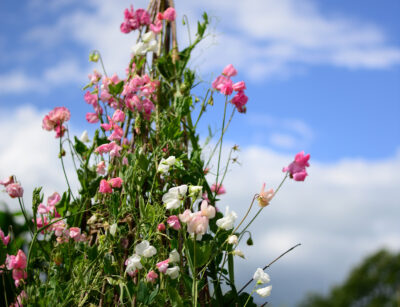
When you hear the word “garden” you’re probably already thinking of plant life. But many aspects of traditional gardens aren’t technically alive. We use fencing, hardscape, furniture, decorative objects, and more in our outdoor spaces. But with a little ingenuity, you can build structures that are living works of art all by themselves.
These ideas will show you what we mean, but there are many more ways to use plant life to add beautiful structure to your garden.
Willow dome. This is the perfect project if you have kids, and want to encourage them to spend more time outdoors. Just bend flexible willow branches into a dome, and then encourage vining plants to grow up the structure. Soon you’re have a unique little hidey place for young children, that encourages imaginative play while adding whimsical beauty to your yard.
A pea or bean teepee. Similar to the willow dome, a pea or bean teepee provides a unique focal point but with less time investment. Place long canes into a teepee shape, and then train bean or pea vines to the form. And as a bonus, you can eat the food you grow!
Espalier tree. Many people don’t realize that they do indeed have room for a fruit tree. Train it to grow up a wall or fence, and this beautiful artwork will also provide delicious fruit in a few years.
A grape arbor. Here’s another option that doubles as a lovely feature and provider of homegrown food. Grape arbors are simple to build, with just a few pieces of wood, and can be as intricate or plain as you like. Train grape vines to the arbor, and enjoy the fruits of your harvest.
An enchanting tunnel. Bend large panels of wire into a tunnel shape, and you can walk through your own tunnel of flowers or even hanging fruits. A variety of gourds provide an interesting visual, because the fruits resemble lanterns.
A living wall. A living wall serves a dual purpose. First, it provides privacy and helps to reduce noise pollution. But it also doubles as a standing planter from which you can grow herbs, ferns, or flowers.
Is your mind churning with ideas yet? We can help you turn them into a reality. Consult with us about adding more life and structure to your yard, and we’ll help you fit a few of these great ideas into your overall landscape design.

Who wouldn’t love their own private, cozy outdoor space, filled with serene, beautiful plant life? If The Secret Garden was a beloved book when you were a child, or you’re just the type to enjoy peaceful seclusion, you will be excited to learn that you can create your own “secret garden” in your backyard. You just need a few creative ideas and a bit of hard work to make it happen.
Here are just a few of the main components that you can use to create a secret garden hideaway. But feel free to personalize as you wish!
An entrance. An entrance defines the space, and lends to that mysterious feeling of enchantment. Use a gate or an arbor covered in vines to mark the journey into your special place.
Provide a pathway. A pathway of blocks, bricks, stepping stones, pebbles, or an actual sidewalk will provide the focal point leading into your private retreat. If your plan is a larger scale project, continue a meandering path throughout the garden as well.
Build a private spot. Fencing, lattice panels, or wrought iron screening can be used to define your cozy space.
Consider lighting. If you’ll be using your secret garden at night, consider a strand or two of twinkly lights above a picnic table or solar lights to line your pathway.
Add a water feature. A bubbling fountain provides the perfect classic centerpiece to a secret garden, and the sound of water will help to mask any noise pollution from your neighborhood.
Know your reason. What do you want from your secret garden? Know your reason, and provide seating or other features that allow you to pass time there.
Fill it with plants. This is the most fun part, at least in our opinion! Once you’ve defined your space and added the necessary hardscaping elements and other features, it’s time to do the actual gardening.
Consider plants that contribute to the mood you want to achieve. If you want a sheltered feeling, fill out the space with shrubs or small trees that will grow overhead. Flowers add beauty, and climbing vines lend a mystical quality.
For more on your landscaping and plant options, call us to discuss your ideas. We can help you determine the right features for your secret garden, and make a plan to put it all together.
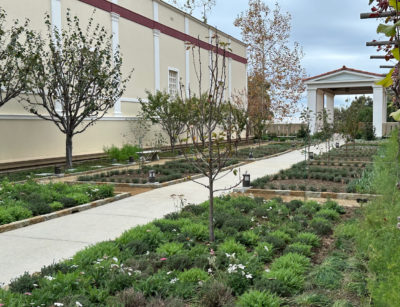
Those of you missing outdoor activities at this time of year might be looking for ideas for a fun day trip. Why not visit the Getty Villa in Malibu? The museum has something to offer everyone in the family, from gorgeous, landscaped grounds, to intricate architecture, to fascinating works of art indoors.
Located on a 64-acre campus overlooking the ocean, The Getty Villa is primarily dedicated to the art and culture of ancient Greece, Rome, and Etruria. The main collection of art includes 44,000 examples of Greek, Roman, and Etruscan antiquities dating all the way back to 6,500 BC. In addition to numerous works of art, the Getty collection also includes ancient books, jewelry, and coins.
But that’s not all you’ll find on the Getty Villa campus. The whole family can take in a theatrical performance or live music in either the indoor or outdoor theaters. Just check the schedule of shows before you go. If you have kids, the museum frequently hosts hands-on activities to help kids feel included.
And of course, we have to mention the gardens! The grounds of Getty Villa feature four different gardens, each planted with plants native to the Mediterranean region. You’ll view boxwood, bay laurel, oleander, and vivarium shrubs, along with rows of date palms. Pomegranate trees anoint each corner of the largest garden, and you’ll spy ornamental plants like ivy, lavender, acanthus, and iris everywhere you look.
If edible gardens interest you, stroll through the Herb Garden. You’ll be inspired by the abundance of traditional herbs along with fruit trees such as fig, apricot, citrus, pear, and apple. And of course, the featured grape vines round out the traditional Mediterranean ambiance. Perhaps you’ll leave with ideas for your own home landscape.
And on that note, give us a call if you’re feeling the landscaping itch this year. We will be happy to help you renovate your outdoor space so that it provides the relaxation, beauty, and ambiance you want for your home.
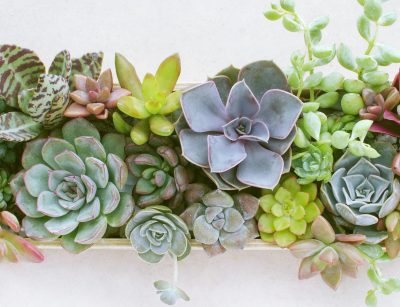
The holidays have come and gone, and if you’re like most people you can’t wait until spring. For now, we’re stuck with the dreary cool weather of January and February. But that doesn’t mean you can’t enjoy some fun nature-themed activities indoors.
Create a succulent garden. All you need is a bag of rocks, a bit of peat moss, and a bowl, pot, or other container. And of course, you should plan on including a variety of succulents. Have fun with various containers and vibrant colors of rocks, and experiment with mixing and matching different shapes, colors, and types of succulents. You can create beautiful centerpieces or works of art for your mantel, while bringing botanical life into your home.
Enjoy a nature-themed LEGO set. Have fun building a lifelike sculpture that you never have to water! LEGO is now producing sets to mimic the look of a bonsai garden, succulents, cut flowers, butterflies, Bird of Paradise, and more. You can achieve the look and ambiance of lively plants indoors without any of the mess. Plus, it’s fun for the whole family!
Grow your own microgreens, herb garden, or mushrooms. Numerous online retailers offer complete kits that allow you to grow your own microgreens, herb garden, or mushrooms right on your kitchen counter. Not only are the activities fun and educational; you can produce fresh, organic food at home. The sets make interesting conversation pieces, too.
Create an air garden. Air plants need almost zero care, and they look cool displayed in hanging glass globes. A collection of them, in varying shapes and hung at different heights, makes a beautiful statement in an otherwise ordinary area such as a kitchen window or the corner of a room.
Plan your spring garden. Maybe you can’t plant anything outdoors yet, but you can start seedlings indoors and begin to nurture them. And the good news is that you don’t need a lot of space to do it. The appropriate UV light and space for a tray or two will allow you to start dozens of seedlings for use in your spring garden. They’ll be half-grown and nearly ready to begin blooming when you transition them outdoors in March.
Of course, if you want to overhaul your landscaping this year, get in touch with us first. We can help you plan your new garden and install new features you will enjoy for years to come.

The cool season has left many of us dreaming of spring, lush gardens, and the scent of roses in the air. That’s why you should take advantage of this time to perform your winter rose care, and encourage your roses to bloom plentifully this year.
What kind of roses do you have? The type of roses you have will determine how much care they need right now. Some especially hardy varieties, like David Austin roses, require very little care. Other types, like hybrid tea or Floribunda varieties, need a bit more care in the winter. But since our weather remains relatively mild here in Southern California, they probably won’t be too much trouble.
If you don’t know what type of roses you have, we can probably help you identify them with a picture of the blooms. Or you can download one of the many smartphone apps that aid in plant identification.
If you grow roses in pots… Simply move the pots to an insulated location, like a gardening shed, and water aparingly when the soil is completely dry (about once per month).
Protect your roses in their dormant period. Roses need to go dormant and stay that way for the duration of the cool season, because off-and-on attempts at growth can damage the plants. Encourage them to remain dormant by not deadheading after fall, holding the fertilizer, and heaping soil or mulch over the base of the plant.
Extra cold-sensitive plants can be insulated with a wire hoop and collar filled with leaves. The leaves will provide a bit of heat as they decompose.
Prune back roses. Once the plants are completely dormant (they should be now) prune canes back to about half their size.
Water occasionally. Roses don’t need much water during their dormant period. If you experience exceptionally dry weather, water your roses lightly if the soil is very dry to the touch.
And as always, give us a call if you have questions about maintaining your landscape at any time. We can advise you on how to keep your outdoor space looking its best all year.

Each January we highlight the Pantone Color of the Year, so that our clients and blog followers can anticipate upcoming trends in home decor and landscape design. This year, we’re excited to announce that Viva Magenta has been named the Color of the Year.
The bold reddish hue is sure to invigorate the design world and excite both designers and homeowners alike. As Pantone’s executive director states, “Rooted in the primordial, PANTONE 18-1750 Viva Magenta reconnects us to original matter. Invoking the forces of nature, PANTONE 18-1750 Viva Magenta galvanizes our spirit, helping us to build our inner strength.”
It’s the perfect shade to liven up both your indoor and outdoor decor, and works well as either a pop of accent color or a courageous use as a main color in your design scheme.
Freshen up your flower beds. This is the most obvious use for Viva Magenta in the outdoor setting. Numerous species of flower are available in this shade, including hybrid roses which are bred to withstand various climate conditions while providing superior beauty and scent to your garden.
Use as an accent color. Outdoors, the easiest way to liven up your decor is to purchase throw pillows, outdoor rugs, and other decorative accents in Viva Magenta. But the shade works well in permanent fixtures, too. You could freshen up your outdoor kitchen with tile accents, for example, or repaint your shutters and other trim on your home.
Feature as a main theme. A single bold color like Viva Magenta need not be relegated to accents only. Create an enveloping ambiance by painting walls with the strong hue, and then incorporate pale shades of beige, green, or blue as accents within furniture and other decor.
Go maximalist. As you might suspect, the maximalist trend directly opposes the earlier trend toward minimalism. With maximalism you artfully blend more than one bold color, along with busy patterns and daring accents, for a look that artfully stimulates the senses without overwhelming them. Viva Magenta would work fantastically with a bold shade of green from the opposite side of the color wheel.
If you’re looking for ways to renovate your exterior decor, particularly your landscape design, call us to discuss your ideas. We can help you stay on trend by incorporating Viva Magenta into your garden, and offer our expertise to help you enjoy your outdoor spaces for years to come.
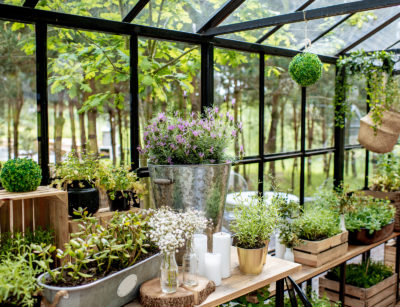
As your interest in gardening grows, you ironically might find yourself longing for more indoor space. We all think of gardening as an outdoor activity, but there are certain times that you need shelter for your plants.
A backyard greenhouse can provide exactly the space you need to expand your gardening hobby, fur a number of reasons:
● Space to shelter warm-season plants during the winter
● A method of expanding your growing season
● A controlled environment for sensitive or young plants
● A convenient place to store gardening supplies
You can accomplish all of these goals within a small or medium-sized backyard greenhouse. But we would advise you to decide upon a size for your structure and then increase it just slightly. Gardening is addictive, and you don’t want to run out of room after investing in a structure!
Site-built versus portable greenhouses. Greenhouses can be as elaborate or as simple as you need them to be. Site-built greenhouses can be designed and built from raw materials, or purchased as a kit that you assemble. The benefit of these types of greenhouses is that it will become a permanent structure in your landscape, and will provide for your needs for years to come. As with anything else, quality will cost you, but it’s usually worth it.
On the other end of the spectrum are portable greenhouses that you assemble from poles and plastic sheeting. These make great options for the gardener on a budget, and they can serve your needs well in a moderate climate. The down side to these greenhouses is that they can easily topple in a windstorm, and the plastic sheeting won’t always last as long as you would like.
Most people can handle the portable or DIY kits. But if you’re interested in a site-built greenhouse that will serve you well for years to come, call us to investigate the options. We can help you design and build a greenhouse that suits your needs and fits seamlessly into your landscape.
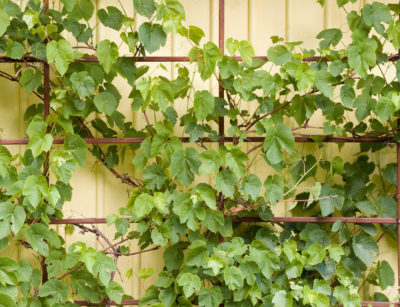
Growing grape vines has become a popular hobby in recent years, both for making homemade wine or simply enjoying the fruit. Plus, grape vines look really cool! But they can quickly become a mess if you don’t train them to grow appropriately. Here’s everything you need to know.
Build a support structure. You can train grapes to grow on just about any support structure you can imagine, such as a trellis or even along a fence. One of the most popular and simple methods involves a series of posts connected by wire, called the high cordon system. Eight-foot posts (buried two feet deep) should be spaced seven to eight feet apart in rows, and connected by wire.
The first year. The first year of growing grape vines is all about establishing healthy plants. Simply tie your new plants to stakes to get them started. When new shoots turn into woody canes as thick as pencils, you can begin training their growth. Tie them to the wire as they grow, encouraging them to climb upward. This part of the process is really quite simple, but requires regular maintenance.
Pruning your grape vines. Once your grape vines reach three years old, it’s time to begin pruning them in the winter.
You can prune grape vines any time after they go dormant, into late February. Later pruning in the dormant season (after New Year’s Day) can reduce incidence of disease. The goal with grape vine pruning can sound severe: You want to remove 85 to 90 percent of all year-old wood.
Start by removing all suckers and cane growth, except for year-old fruiting canes. Old canes are gray and shaggy, whereas newer canes are smooth and reddish to bronze in color.
Cut back fruiting canes so that 15 buds remain. You want to end up with 50 to 80 buds per plant. Cut some canes back to renewal spurs, evenly spaced along the wire to ensure balanced growth. Suitable canes for this type of pruning will be at least the diameter of a pencil at the cut end.
And if you worry you’ve gone overboard with your pruning, just continue watering your grape vines during dry weather and fertilize them as usual. You really can’t over-prune grapes! Have no fear; they will return in full force next year.
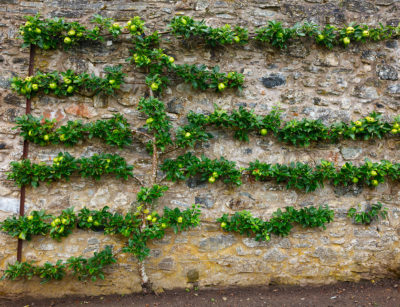
Many of us tend to think of landscaping as a rather static installation. You plant some shrubs and trees, perhaps install a flower garden, and then you simply maintain your landscaping for years to come. And yes, you can do it that way. But landscape design can be much more dynamic, incorporating the latest trends for a look that never feels boring or outdated.
In fact, nurseries are constantly developing new varieties of flowers, shrubs, and trees for both aesthetic and practical purposes.
Blueberries and cream petunia. This new variety of petunia sounds delicious, and the flowers are as pretty as their name implies. Deep purple-blue blooms are edged with true cream (not white), making a truly dramatic petunia. And best of all, these blooms appear just as bright and striking on the shady side of the plant.
Glimmer double impatiens. Sometimes gardeners can feel limited by full sun requirements. But if you’re looking for a beautiful flower that grows in partial sun or shade, consider the new mildew-resistant glimmer double impatiens. They look like tiny roses, and are available in six colors. The pale pink shade, called Appleblossom, is sure to be a hit with gardeners who enjoy classic, understated looks.
Sun dipper tomato. For you vegetable gardeners out there, here’s a fun, new little tomato variety. Sun dippers grow to about an inch long, are shaped like tiny bowling pins, and ripen to a dark orange hue. Because they’re indeterminate tomatoes, you can expect enormous plants (that must be staked) which will produce all summer long. Aside from tasting delicious, these cute little tomatoes are quite ornamental!
Moody roses. For 2023, moody colors are all the rage. And that trend is reflected in the world of roses, too. David Austin is releasing several new rose varieties that fit perfectly with the 2023 mood, including Rose Tess (a deep, passion red), Rose Juliet (a peach rose with a deep, apricot heart), and Rose Beatrice (a creamy peach rose featuring a rich, apple-almond scent).
Espalier trees. In a nod to the explosion of interest in home gardening, many nurseries are focusing extra attention on developing new varieties of fruit trees. But for those of us with smaller yards and limited room, the espalier tree can provide the perfect solution. With several varieties of fruit grafted onto one tree, you can enjoy fresh apples, pears, peaches, or plums from a single plant!
If any of the above descriptions strike your fancy, or if you’re just ready to renovate your landscape in general, give us a call. We can discuss your vision in more detail and help you plan a project that provide beauty and enjoyment for years to come.

It’s almost that time of year again: Out with the old, and in with the new! If refreshing your indoor or outdoor spaces falls on your resolutions checklist, consider these six emerging trends for 2023.
Colors will go dark and moody. We often worry that dark colors will make a room feel smaller. But another way to look at dark rooms is “cozy”. With the right lighting and accents, dark colors like chocolate brown, black, navy blue, inky purple, or deep green can make you feel enveloped and snug. Pops of brighter accents lend balance, and the overall effect is rich and soothing to the senses.
Colored marble. We’ve all trended toward more natural and organic materials for some time now, but it seems everyone is getting bored with earth tones. Colored marble might be exactly what the bored homeowner requires to spruce up flooring or countertops while holding on to that “natural” feel.
More “life” in design. Speaking of those natural materials, biophilic design is still huge. Interior designers are bringing more plants indoors, along with organic touches like woven baskets, unfinished wood, and pottery. We’re stripping away the division between indoor and outdoor life, and creating a mood that flows seamlessly from living room to patio, and dining room to outdoor kitchen.
Bold patterns. Say goodbye to boring solids, and hello to bold patterns that make a space feel lived-in and inviting. Everything from wallpaper and throw pillows, to tile flooring and backsplashes will boast bold patterns in 2023.
Making the old new again. Supply chain problems, combined with a nostalgia for simpler times, have motivated many of us to look twice at vintage items. Thrift shop finds can be spruced up with a coat of paint or new fabric, and who knows what you might find when you raid Grandma’s storage unit.
Hand-crafted items. Supply chain hang ups have had many of us turning to local artisans for unique, hand-crafted items. Not only will your decor feel more personal; you can support your local community too.
Reading through these trends, does something spark an idea for you? Give us a call and we can help you renovate your outdoor kitchen, patio, pool area, and other backyard living spaces. By incorporating just a few new trends you can keep your space feeling current for years to come.
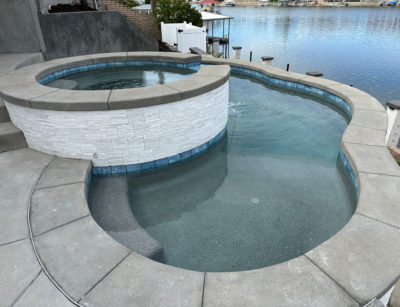
The completion of any landscaping project is an exciting time, and pools are perhaps the most exciting thing of all. Not only is your new pool a gorgeous addition to your backyard, but it promises fun and relaxation for years to come. So now that your new pool is installed, take a step back and enjoy it.
Of course, your next question might be, “Now what? How do I maintain my pool so that it stays beautiful and functional for years to come?” Here’s what you need to know as a new pool owner.
Set a schedule for maintenance and cleaning. This is a new chore for you, so you’re not used to it yet. Mark pool maintenance and cleaning chores on your calendar so that you never forget anything.
Keep it safe. Most municipalities impose rules on pool safety, but you want to be safe regardless. Remember to make checking your gate latch, setting the pool alarm, and covering the pool part of your daily routine (depending upon which safety features you chose). As with your cleaning schedule, it can be easy to forget new chores. Set an alarm on your phone to remind you of important safety tasks.
Mark a date for pool resurfacing. Your pool won’t need resurfacing for many years to come, depending upon the type of pool you chose. But it will sneak up on you faster than you think! Keep this estimated date in mind, so that you can make room in your budget that year.
Be safe about storing chemicals. Pool chemicals can be hazardous, so choose a safe and secure spot for them.
Consider a pool maintenance company. Doing all the work yourself can be tempting, but life gets busy and chores can be skipped. If you hire a pool maintenance company, you’re assured of timely and appropriate pool care, with zero hassle.
Plan your next project. Part of the fun of pools is that you can always add features to make them more attractive and enjoyable. Take note of your ideas for future projects, whether you’re considering landscaping around the pool, adding a deck, installing colored lights, or building an outdoor kitchen to host parties. Give us a call when you’re ready to expand your fun zone!
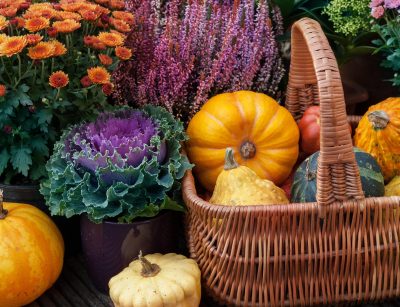
Thanksgiving is just around the corner, and many of you are busy planning your menus and shopping for ingredients. But what’s a great meal without a beautiful table? Have you had time to consider a seasonal centerpiece that will accentuate your meal?
Yes, it’s just one more chore to add to your list! But a beautiful Thanksgiving centerpiece doesn’t have to be overly expensive or time consuming. In fact, you can use botanical objects that you find in your own yard!
Use fresh produce. If you grow a vegetable garden, your fall harvest can provide the perfect “ingredients” for a beautiful autumn centerpiece. A selection of squashes and pumpkins can form the basis of your arrangement. From there you might wish to add a few ears of corn, apples, or other interesting fall-themed produce.
Fill a vase. Sunflowers are perfectly on-trend right now, and they just happen to make terrific autumn-themed decor. But remember, you can fill a vase with more than just flowers. Decorative grasses make an excellent accompaniment to your blooms.
Make a garland. Or how about a garland that runs the length of the table? You can create a gorgeous, low-budget decoration from branches, autumn-colored leaves, pinecones, and acorns. Or make long-stemmed sunflowers the basis of your garland, and add accents of different colors.
Use squash for a container. Hollow out a few squash or pumpkins, and use them as a “vase” for chrysanthemums or other seasonal blooms.
Fill a bowl. Sometimes making a beautiful centerpiece can be a simple as filling a bowl with pinecones, twigs of berries, and other objects of interest. Remember to vary sizes and colors to make your arrangement visually interesting.
We hope your Thanksgiving is memorable and beautiful. And if you want to discuss planning a fall-blooming garden for next year, or any other landscaping project, give us a call. We want to help you enjoy your home all year round.
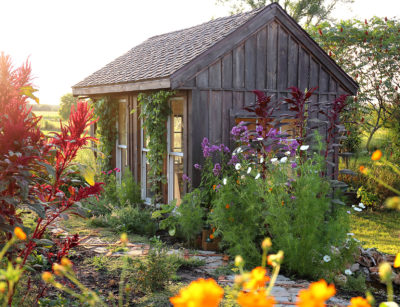
Like many homeowners, you might require a backyard shed to store your gardening equipment. But the shed itself can serve as an eyesore that detracts from your overall landscaping. The key is to carefully plan the landscaping around your shed, so that it blends in seamlessly with the rest of your backyard.
First, of course, you want to choose a location for your shed that is convenient for use without placing the shed directly in the middle of your view. Its purpose is not to become a focal point, after all. But after placing your shed, you can certainly use various landscaping tricks to help it become an attractive part of your overall scheme.
Then, consider a pathway of sorts. Anything from stepping stones, to slices of an old stump, to a more sophisticated paved path will work. When you install a pathway to your shed, the building itself will feel more intentional.
Next, consider various plantings to accentuate your shed. Shrubbery will help it to blend with the rest of the landscaping. Or, consider lattice along one side, and plant a climbing vine. If your budget is tight, simply placing a few larger potted plants around the entrance to the shed can help it seem more inviting.
How about a small flower garden along the sides of the shed? Simply turn the earth, add a border, and remember to add attractive mulch to preserve moisture and protect your plants from weeds.
If your shed has windows, installing window boxes planted with flowers and herbs will add a quaint touch. Add a small bench or other decorative object out front, and your shed will look more like a cute guest cottage.
If you want to conceal the shed, a living wall or a row of taller hedges can do the trick.
For more backyard landscaping ideas, give us a call. We can discuss your goals for the space and then help you decide upon a plan that suits your needs.

If you live in a neighborhood with sidewalks, you probably appreciate the walkable atmosphere and better connection with your neighbors. But sidewalks also present a challenge for your landscaping. What do you do with that strip of yard between the sidewalk and road? How can you make it attractive, without causing any problems?
It’s called the “hellstrip”, a term coined by Evelyn Hadden, author of “”Hellstrip Gardening.” As Evelyn observed, hellstrips tend to collect waste from neighborhood dogs, trash that has been deposited by the curb, and excess foot traffic from those who park on the street. And unfortunately, that little strip of land between pavement and sidewalk tends to dry out. Hellstrips can quickly become eyesores and detract from the curb appeal of your home.
But resist the temptation to sigh, accept the mess, and give up! With a combination of ingenuity and practicality, you can landscape your hellstrip to add beauty to your front yard.
First, remember to work with conditions rather than against them. The nature of hellstrips (dry and frequently traveled) makes them unsuitable candidates for a typical lawn. Instead, you should plant a garden in this spot that will work with those conditions, rather than against them.
Native plantings do well in hellstrips here in Southern California, because they’re evolved to be well suited for a dry environment. Choosing low-water shrubs, decorative grasses, and perennials will also cut down on the need for watering.
Xeriscaping also works well in hellstrips, so investigate the possibilities regarding colored pebbles or rocks as a substrate. Larger boulders can be decorative as well, and discourage those who want to take a detour from the sidewalk.
Do remember to keep plants under three feet in height, and don’t choose something that will put out large roots that disrupt the road, sidewalk, or your own driveway (such as trees that will grow large). Check your local restrictions to ensure you don’t break a rule that results in a fine and the need to remove landscaping.
To learn more about hellstrip landscaping, and to plan a small but impactful garden in your own front yard, give us a call to discuss your ideas.
